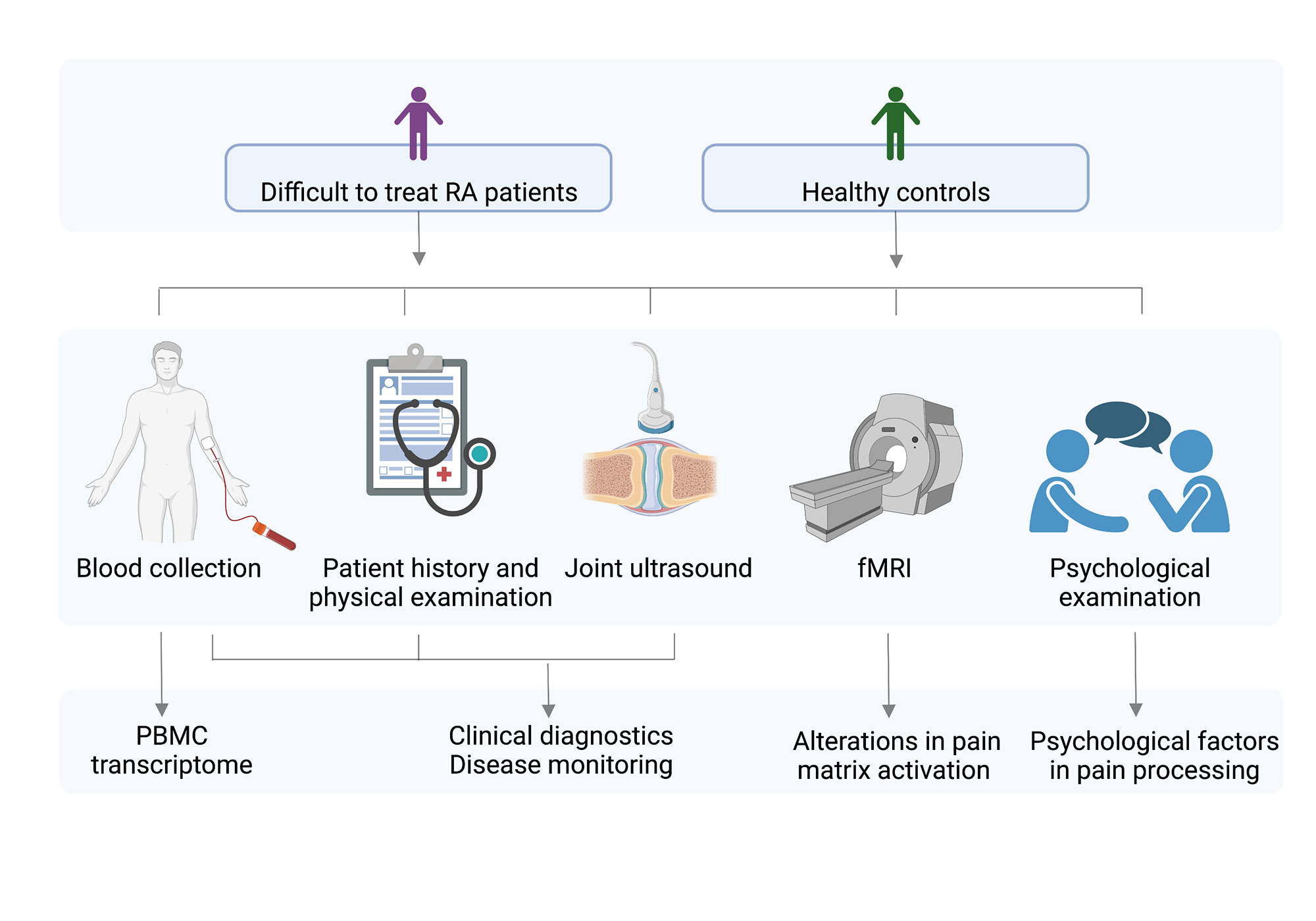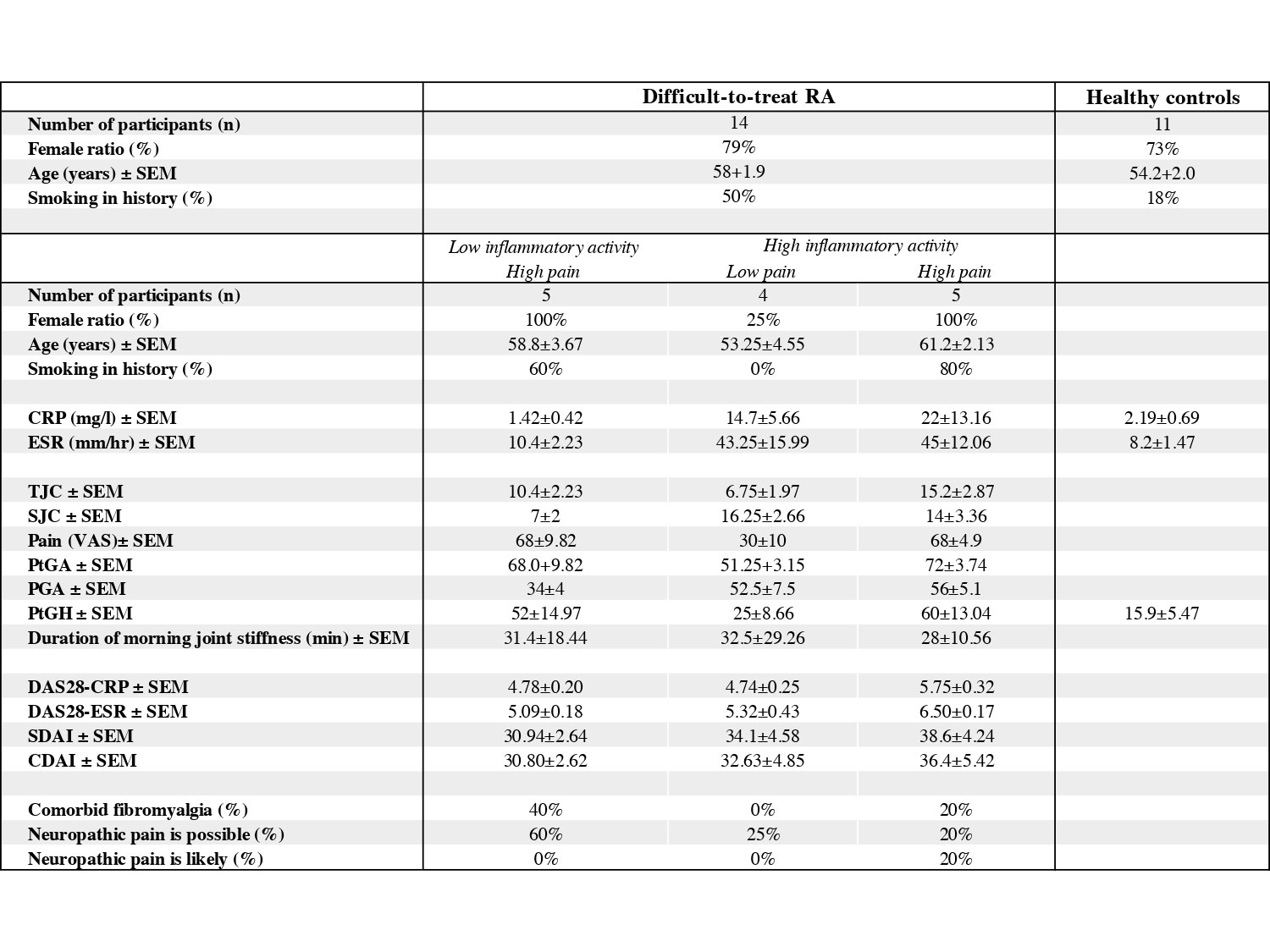Session Information
Session Type: Poster Session D
Session Time: 1:00PM-3:00PM
Background/Purpose: Despite the therapeutic advances of rheumatoid arthritis (RA), optimal disease control cannot be achieved in the difficult-to-treat (D2T) RA population, leading to the persistence of symptoms, especially pain. Multiple factors contribute to pain in RA, including inflammation, dysfunctions of the ascending pain processing and descending inhibitory pathways, structural damage, as well as physical and psycho-social comorbidities. However, the pathophysiological mechanisms are still unclear. Our aim is to examine the processes in the background of RA pain with a multidisciplinary approach and to reveal the interactions among pain, inflammation, psychological and social factors.
Methods: 11 healthy controls (HC) and 14 RA patients fulfilling the 2020 EULAR definition to D2T RA were included. Clinical examination including musculoskeletal ultrasound, psychological analysis (personal clinical interview, Rorschach test and validated surveys) and functional MRI (fMRI) with standardized painful heat stimulation was performed. Blood was drawn for diagnostic and experimental purposes. (Figure1)
Results: The clinical examinations identified 3 subpopulations within D2T RA on the basis of the intensities of the inflammatory reaction and pain (Table1). Our psychological survey showed that RA patients had higher rate of depression, experienced somatic complaints, had trouble in movement, movement phobia, an increased proportion of pain, avoidance of painful activities, sensitivity to pain, and dependence. Among the pathological cognitive schemes: “vulnerability”, “feeling of fragmentation (isolation)”, “phantasy of rejection” scheme and decreased “autonomy and work ability” scheme was detected compared to HC. Patients have higher trait anxiety; however, not free-floating anxiety (GAD), but anxiety about movement and performance. In general, their psychological feelings are also decreased. This untreated pain focused cognitive nonadaptive negative fixations, anxiety dissociated in somatic perceptions and mood disorders could lead to the failure of medical therapies. fMRI examinations revealed several differences in the activation pattern of pain related structures between HC and RA populations. After painful stimulation, the functional connectivity strength (FCS) between prefrontal and posterior cingulate cortices was reduced in HC, whereas it increased in RA patients. FCS within the default mode network (DMN) and between DMN and frontoparietal network, as well as in several connections of the anterior medial prefrontal cortex (aMPFC) were also reduced in HC. This pattern was not present in patients, moreover, pain rather increased the FCS between aMPFC and lateral occipital cortex in the RA population. PBMC isolation and RNA extraction reached high quality in all samples, transcriptomic analysis is currently going on to determine pain-related pathways, mediators and targets.
Conclusion: We revealed several abnormalities in the pain processing pathway and pain matrix activation in the brain of RA patients with persistent pain compared to HC. Psycho-social factors also strongly influence the perception of pain in RA.
Difficult-to-treat RA patients: according to EULAR definition of diffictult-to-treat RA
PBMC: peripheral blood mononuclear cells, fMRI: functional MRI
Created with biorender.com
Low inflammatory activity, high pain: DAS28 ≥ 3,2 AND CRP ≤ 5 mg/L OR ESR ≤20 mm/h AND VAS ≥ 60 mm; High inflammatory activity, low pain: DAS28 ≥ 3,2 AND CRP > 5 mg/L OR ESR > 20 mm/h AND VAS ≤ 60 mm; High inflammatory activity, high pain: DAS28 ≥ 3,2 AND CRP > 5 mg/L OR ESR > 20 mm/h AND VAS ≥ 60 mm
RA: rheumatoid arhtritis; SEM: standard error of the mean; CRP: C-reactive protein; ESR: erythrocyte sedimentation rate; TJC: tender joint count SJC: swollen joint count; VAS: visual analogue scale (0_100 mm), PtGA: Patient’s Global Assessment of Disease Activity (higher scores indicate increased arthritis disease activity) PGA: Physician’s Global Assessment of Disease Activity (higher scores indicate increased arthritis disease activity); PtGH: Patient’s Assessment of Global Health (higher scores indicate decreased global health); DAS28-CRP: disease activity score 28 using C-reactive protein; DAS28-ESR: disease activity score 28 using erythrocyte sedimentation rate; SDAI: simple disease activity index; CDAI: clinical disease activity index; Comorbid fibromyalgia is based on the 2016 revision of the American College of Rheumatology 2010/2011 diagnostic criteria (Widespread pain index (WPI) ≥ 7 and symptom severity scale (SSS) score ≥ 5 OR WPI of 4–6 and SSS score ≥9 AND widespread pain affecting at least 4/5 body regions AND symptoms have been present for at least 3 months); Neuropathic pain possibility and likeliness is based on the PainDETECT questionnaire
To cite this abstract in AMA style:
Tóth L, Orsi G, Csókási K, Sütő G, Kumánovics G, Császár-Nagy N, Takács S, Szigedi E, Nagy Z, Hodovány Z, Duzsik L, Vidnyánszky Z, Kun J, Urbán P, Nagy G, Helyes Z. Comprehensive Investigation of Pain and Inflammation in Rheumatoid Arthritis from a Multidisciplinary Approach [abstract]. Arthritis Rheumatol. 2022; 74 (suppl 9). https://acrabstracts.org/abstract/comprehensive-investigation-of-pain-and-inflammation-in-rheumatoid-arthritis-from-a-multidisciplinary-approach/. Accessed .« Back to ACR Convergence 2022
ACR Meeting Abstracts - https://acrabstracts.org/abstract/comprehensive-investigation-of-pain-and-inflammation-in-rheumatoid-arthritis-from-a-multidisciplinary-approach/


